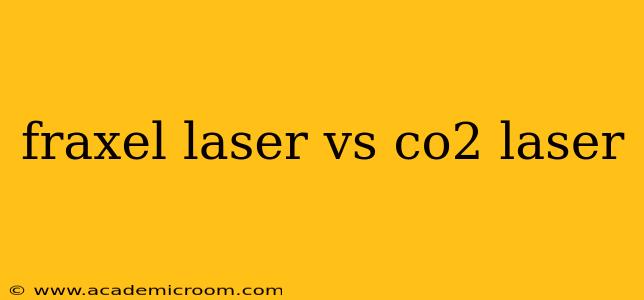Choosing between a Fraxel laser and a CO2 laser for skin resurfacing can feel overwhelming. Both treatments offer impressive results in improving skin texture and reducing the appearance of wrinkles, scars, and age spots, but they differ significantly in their approach and recovery time. This comprehensive guide will delve into the key differences, helping you make an informed decision based on your individual needs and preferences.
What is a Fraxel Laser?
Fraxel lasers use fractional technology, meaning they only treat a fraction of the skin's surface at a time. This allows for a more controlled treatment with less downtime compared to a CO2 laser. The laser creates microscopic columns of injury, triggering the skin's natural healing process to stimulate collagen production and cell renewal. This results in gradual improvement in skin tone and texture. Multiple treatments are usually necessary for optimal results.
Types of Fraxel Lasers:
There are two main types of Fraxel lasers:
- Fraxel re:pair: This is a more aggressive treatment that targets deeper layers of the skin and is suitable for more significant skin concerns like deep wrinkles and acne scars. Expect a longer recovery period with this type.
- Fraxel Dual: This offers a more versatile approach, combining the benefits of both ablative (removing the top layer of skin) and non-ablative (heating the deeper layers without removing skin) technologies in one treatment.
What is a CO2 Laser?
A CO2 laser is a more aggressive form of skin resurfacing. It uses a high-powered beam of light to remove the top layers of skin, stimulating significant collagen production. This results in a dramatic improvement in the appearance of wrinkles, scars, and age spots. However, the recovery time is significantly longer, often involving several weeks of downtime. CO2 lasers are often considered a more intense treatment for more severe skin concerns.
Types of CO2 Laser Treatments:
CO2 laser treatments can also be performed in different ways:
- Full-face resurfacing: This involves treating the entire face with the CO2 laser.
- Fractional CO2 laser resurfacing: This utilizes fractional technology, similar to Fraxel, but with a more powerful CO2 laser. It allows for a less extensive recovery period than full-face resurfacing but still longer than a Fraxel treatment.
Fraxel Laser vs. CO2 Laser: Key Differences
| Feature | Fraxel Laser | CO2 Laser |
|---|---|---|
| Intensity | Less aggressive | More aggressive |
| Downtime | Shorter, typically a few days to a week | Longer, typically several weeks |
| Recovery | Gradual improvement | More dramatic, immediate visible improvement |
| Number of Treatments | Usually requires multiple treatments | Often requires fewer treatments |
| Suitable for | Mild to moderate skin concerns | Moderate to severe skin concerns |
| Cost | Generally less expensive | Generally more expensive |
What are the side effects of Fraxel and CO2 laser treatments?
Both Fraxel and CO2 laser treatments carry potential side effects. These can include redness, swelling, bruising, and crusting. The severity and duration of these side effects depend on the type of laser used and the individual's skin type. It is crucial to discuss potential risks and side effects with your dermatologist before undergoing either treatment.
Which laser treatment is right for me?
The best choice between a Fraxel laser and a CO2 laser depends on several factors including your skin type, the severity of your skin concerns, your desired outcome, and your tolerance for downtime. A consultation with a qualified dermatologist is essential to determine the most appropriate treatment plan for your individual needs. They can assess your skin, discuss your goals, and recommend the laser treatment that will yield the best results while minimizing risks.
How long does it take to see results from a Fraxel laser treatment?
Results from a Fraxel laser treatment are gradual. You may see a noticeable improvement in your skin texture and tone within a few weeks, with continued improvement over several months as collagen production continues.
How long does the recovery period last after a CO2 laser treatment?
The recovery period after a CO2 laser treatment can last several weeks, sometimes even months. During this time, you may experience significant redness, swelling, and crusting. Your dermatologist will provide specific aftercare instructions to ensure optimal healing.
Are there any alternatives to Fraxel and CO2 laser treatments?
Yes, several alternative treatments can address similar skin concerns, such as chemical peels, microdermabrasion, and microneedling. Your dermatologist can help you explore all available options and recommend the most suitable approach based on your individual circumstances.
By understanding the nuances of Fraxel and CO2 laser treatments, you can embark on your skin rejuvenation journey with confidence and realistic expectations. Remember, consulting a qualified dermatologist is the crucial first step towards achieving your desired results.
